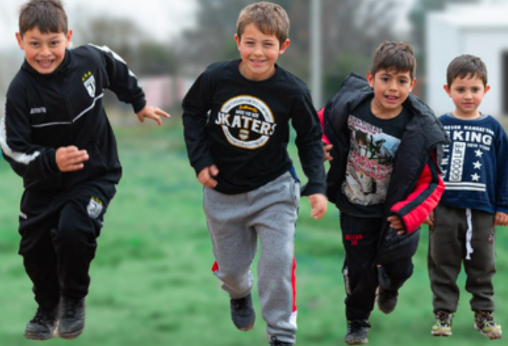
Sixty percent of the newcomers are children that have immediately improved their health, education, and lives.
Watch this video to get closer to the desires, feelings and experiences of the children and young people who are part of “Welcome to my Village”:
In cooperation with the Swiss Embassy, local government, and private sector, we implemented a highly successful, award-winning, and media-acclaimed pilot project in Argentina, which ran from 2015 to 2019. We focused on a small community, Colonia Belgrano, located near two fast-growing cities. It had high unemployment and young people were leaving in droves.
Argentina was selected as our first site. Unsustainable migration had left 92% of the country’s population living in urban areas, 8% in rural areas, and hundreds of rural towns largely depopulated, despite their proximity to large cities and, in some cases, ample infrastructure.
Young people are no longer thinking of leaving the village.
The impact was astounding. The town’s population grew 10% in one year. 60% of the newcomers are children that have immediately improved their health, education, and lives. Of those receiving training and mentoring, 100% launched a business, and these entrepreneurs increased their income an average of 40% in the first year. Over three years, local employment rose 15%. The real estate sector also grew, with more than 35 new houses built, a 575% increase in the number of houses for rent (27 versus four) and a 716% increase in the number of new plots listed for sale (46 v. 4). Village inhabitants stop fleeing to the city. Young people are no longer thinking of leaving the village. Despite the pandemic, Colonia Belgrano still has full employment and there is a waiting list of people who want to rent houses and settle in the village, with new businesses continuing to open in 2020 and 2021.
The pilot emphatically proved our three core hypotheses
First, people live where they can, not where they want. More than 20,000 families signed up for the program in just 4 weeks, demonstrating the high interest for a life change, even before the pandemic.
Second, rural communities have economic opportunities to offer beyond the agricultural sector, taking advantage of opportunities beyond agribusiness (shortage of services and products) and harnessing technology. During our pilot, 25 new businesses not related with agribusiness were created.
Third, migration trends are reversible. People chase the opportunity. With a mix of economic opportunities, the necessary incentives and support for relocation, and the infrastructure, the problem of urban overcrowd and rural depopulation can be solved.
Our average client’s experience
Growth in 3 years. | Metric | In May 2016 | In May 2019 |
100% | WELCOME | (*) Suffered from poor health, endured dangerous living conditions, felt socially isolated, disconnected from neighbors | Feel they have found their place in the world, know their neighbors’ names, help and receive help from their neighbors, volunteer in their community |
100% | BUSINESS | (*) Lived as informal entrepreneurs in survival mode, did not pay taxes; possessed technical knowledge and experience in construction and textile production, but did not have business savvy; lacked connections or work network, forcing them to “go it alone” | Run successful businesses with living incomes; operate in the formal economy and pay taxes; operate with a business plan that guides business decisions, such as marketing, new ventures, and product launches; evaluate decisions based on risks and business performance thanks to business training; network with other entrepreneurs. |
100 % | Home | (*) Rented or lived with relatives, tyically under precarious and uncomfortable circunstances | Own their own homes, often in custom-built houses with yards or gardens |
Rural Community Success
Growth in 3 years. | Metric | In May 2016 | In May 2019 |
575% | Rented Houses | 4 short-term rentals | 27short-term rentals |
900% | New homes built with private financing | 1 | 10 |
716 % | Plots of land acquired to build new homes | 6 | 49 |
316% | New homes built with social financing | 6 | 25 |
10% | Population growth | 1284 | 1420 |
+5 | New constructions of shops and workshops | 5 | |
+25 | New businesses nor related to agriculture business | 25 | |
+27 | Employment in non-agricultural businesses | 27 |
(*) The beneficiaries are chosen based on the business opportunities in the locality.
In the pilot, complying with the requirement of the government of Argentina, we look for low-income families, but at scale, with our advice we open that criterion. Although, the program will always focus on supporting those who need it most. We have to create a thriving community. There are many workers in home-based businesses, as well as freelancers, programmers, and service providers that do not live in the poorest conditions. These people greatly enrich the social fabric. It is also about selecting small businesses capable of generating productive investment in the town. Also profiles meeting the needs of local companies which do not find adequate profiles in the area. Priority will also be given to people with children, because the goal is to promote repopulation and rooting, and children are important promoters of rooting. Also, because we seek to create maximum impact, and that is achieved when we include the younger generations!
